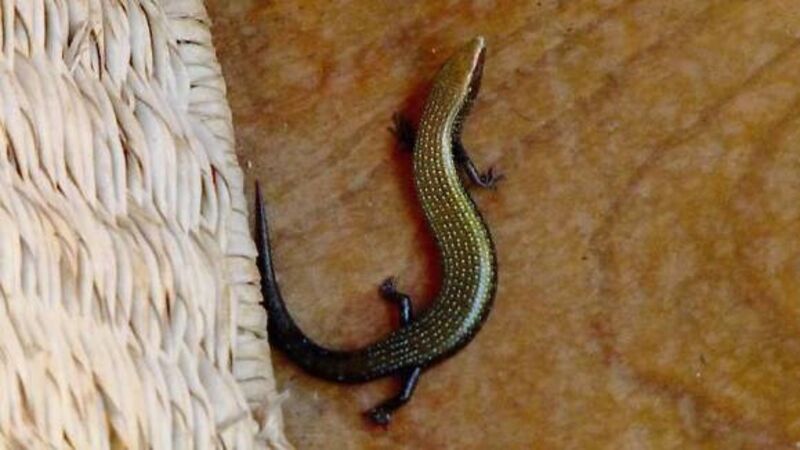Easeful meditation watching a skink’s exotic dance

Skinks catching the sun might be mistaken for dribbles of gold escaped from a smelter. Glossy black skins peppered with gold spots, they are strange creatures, neither lizard nor snake, somewhere in between.
It’s as if they want to be rid of their legs altogether and that is what evolution has in mind for them — to make life easier by breeding out troublesome lizard legs and lizard scales and polish the body to smooth, sinuous, seamless skin that will slide with snake-like smoothness over any surface and yet will have the sort of inherent traction that will allow its owner to climb using a mechanism not unlike the countless tiny hairs that allow geckos to stick to ceilings without falling.
Today, as I write, lizards skitter about my feet and blackbirds serenade me. It is 2.30pm on a Canary Island day, mainly dull. The skink that comes to the dog’s water bowl hasn’t yet appeared: skinks love the sun and cannot activate until they’ve had their fill of it.
This is Barbara’s garden, a magical place with a lexicon of flora and fauna and a cuarto de aperos (a tool shed) which she has kindly allowed me to turn into a makeshift workroom during my island stay.
I come here because there’s nobody about: only me and the creatures, of which there are many, and of diverse varieties. It is deep in the banana plantations, a patch of ground she’s planted with flowers and fruit trees, and where she sometimes spends entire days pottering about with plants.
I love it for the solitude and seclusion, and for the multiple creatures that share it with me.
I don’t move about much; they act as if I’m not there. I think the skink that shyly slips out of a crevice in the wooden floor beside my feet and slides to the dog’s bowl to take a sip of water, is my favourite.
It explores the floor to search for crumbs that might have fallen from my lunchtime sandwich, and then leaves the shade to bask in the sun.
The studied basking of the toolshed skink is an essay in relaxation. It lifts its rear legs onto its back, thus marrying the length of its entire body (about 20cm) with the warm floor boards.
On some days, it prefers to prostate itself on a scrap of old rug with a faded oriental pattern. There, it shines like a gold pendant dropped by an oriental queen.
The skink doesn’t appear until an hour after the lizards are already skittering about on the stone walls and making high speed foraging dashes onto the boardwalk.
The lizards eat fruit with great gusto. The other day, my son and his wife left an over-ripe peach in their yard and soon a half dozen lizards had congregated to eat it.
The daytime birds of the toolshed patch are chiffchaffs, kestrels and blackbirds. The blackbirds are, possibly, the most vocal I have ever heard: from early afternoon, they sing in their loudest contraltos, pouring their hearts out in all the banana plantations and from the mango, avocado and guava groves.
Occasionally, an outraged flurry of alarm notes is let loose as if a bird’s been goosed. Why the panic, I have no idea.
A pair nest in a 4m high mango tree near my work shack and take turns to fly almost perpendicularly to the crown of a 30m-high solitary Canary palm, Phoenix canariensis, there to harvest dates to feed their nestlings. They literally climb the sky. As in Ireland, fruit is a major part of blackbirds’ diet.
These last few days, spinning across their flight path like mini-rockets, are the jet-black cruciform shapes of pallid swifts, flashing silver when they catch the sun.
The size of our barn swallows, they winter in southern Africa or southeast Asia and nest in cliffs on Mediterranean and Canary islands.
They are more secure than the swifts in Ireland, Apus apus, which often rely on buildings for nesting sites. As a result of house demolition and remodeling populations have fallen 40% between 1998 to 2013.
As evening draws in, frogs croak, bats to fly, and an owl sometime appears on a dead trees two fields away.
When night falls, the pardelas, broad-winged Cory’s shearwaters, come in from the sea and circle high above the villages, crying like children. On dark nights, they alarm visitors but they can be seen against the sky when there is a moon.












